
Back Jiang Shi German Ĝjangŝio Esperanto Jiang Shi Spanish جیانگشی Persian Jiangshi French Jiangshi Croatian Jiangshi ID キョンシー Japanese 강시 Korean Jiang Shi Malay
| Jiangshi | |||||||||||||||||||||||
|---|---|---|---|---|---|---|---|---|---|---|---|---|---|---|---|---|---|---|---|---|---|---|---|
 Two people dressed up as jiāngshī. Here, the fulu is hanging from the forehead. | |||||||||||||||||||||||
| Chinese name | |||||||||||||||||||||||
| Traditional Chinese | 殭屍 | ||||||||||||||||||||||
| Simplified Chinese | 僵尸 | ||||||||||||||||||||||
| Hanyu Pinyin | jiāngshī | ||||||||||||||||||||||
| Literal meaning | stiff corpse | ||||||||||||||||||||||
| |||||||||||||||||||||||
| Vietnamese name | |||||||||||||||||||||||
| Vietnamese alphabet | cương thi | ||||||||||||||||||||||
| Chữ Hán | 殭屍 | ||||||||||||||||||||||
| Korean name | |||||||||||||||||||||||
| Hangul | 강시 | ||||||||||||||||||||||
| Hanja | 殭屍 | ||||||||||||||||||||||
| |||||||||||||||||||||||
| Japanese name | |||||||||||||||||||||||
| Kana | キョンシー | ||||||||||||||||||||||
| |||||||||||||||||||||||
A jiāngshī (simplified Chinese: 僵尸; traditional Chinese: 殭屍; pinyin: jiāngshī; Jyutping: goeng1 si1), also known as a Chinese hopping vampire,[1] is a type of undead creature or reanimated corpse in Chinese legends and folklore. It is typically depicted as a stiff corpse dressed in official garments from the Qing dynasty.
In actual folkloric accounts, it is capable of giving chase by running, and if sufficiently old, also of flying. In popular culture, however, it is represented as hopping. In folklore, it is either represented as anthropophagous, therefore resembling Slavic vampires, or as killing living creatures by absorbing their qi, or "life force", rather than as blood-sucking in the West European conception.[2]
During the day, it rests in a coffin or hides in dark places such as caves.[3] Although the pronunciation of jiangshi varies in different East Asian countries, all of them refer to the Chinese version of vampire.
De Groot suggests that the belief in jiangshi was the result of the natural horror at the sight of dead bodies, nourished by the presence of unburied corpses in the imperial China, which "studded the landscape", the idea of the vital energy flowing through the universe as capable of animating objects - including exposed corpses, and by severe cultural taboos concerning postponement of burial.[4] These fears are described as having preoccupied "credulous and superstitious minds in Amoy".
The belief in jiangshi and its representation in the popular imagination was also partly derived from the habit of "corpse-driving",[5][6] a practice involving the repatriation of the corpses of dead laborers across Xiang province (present-day Hunan) to their hometowns for burial in family gravesites. The corpses were trussed up against bamboo sticks and carried by professionals known as corpse-drivers and transported over thousands of miles to their ancestral villages, which gave the impression of a hopping corpse. These professionals operated during the night to avoid crowds during the day, which served to amplify the fearful effects of their trade.
Jiangshi legends have inspired a genre of jiangshi films and literature in Hong Kong and the rest of East Asia. Movies such as Mr. Vampire and its various spin-offs Mr. Vampire II, Mr. Vampire III, and Mr. Vampire IV became cult classics in comedy-horror and inspired a vampire craze in East Asia, including Taiwan and Japan. Today, jiangshi appear in toys and video games. Jiangshi costumes are also sometimes employed during Halloween.

- ^ Lam, Stephanie (2009). "Hop on Pop: Jiangshi Films in a Transnational Context". CineAction (78): 46–51.
- ^ De Groot. "10, Spectres with a Material Body, Vampirism". Religious System of China, Volume 5. p. 745.
- ^ "Search Results – Mythical Creatures Guide".[dead link]
- ^ Cite error: The named reference
:2was invoked but never defined (see the help page). - ^ "A Mystery in Western Hunan: Walking Corpse". en.chinaculture.org. Retrieved 2024-07-10.
- ^ "Old China practice of corpse herding to transport bodies to hometown for burial". South China Morning Post. 2024-06-02. Retrieved 2024-07-10.
© MMXXIII Rich X Search. We shall prevail. All rights reserved. Rich X Search